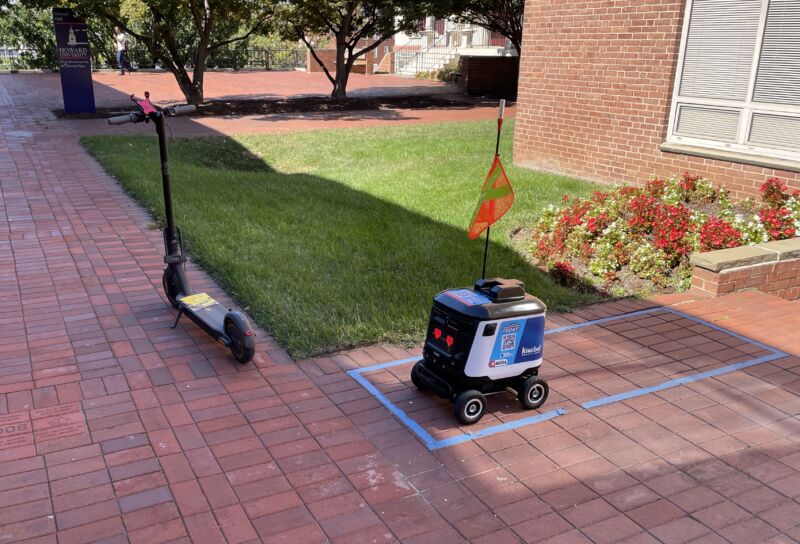

The robot takeout revolution is closer than you think
source link: https://arstechnica.com/cars/2022/10/the-robot-takeout-revolution-is-closer-than-you-think/
Go to the source link to view the article. You can view the picture content, updated content and better typesetting reading experience. If the link is broken, please click the button below to view the snapshot at that time.

Sidewalk robots —
The robot takeout revolution is closer than you think
I learned a lot ordering a donut and a muffin from delivery robots.
Timothy B. Lee - 10/6/2022, 2:00 PM

I’d been following the robot for about five minutes when it seemed to get hopelessly lost.
The four-wheeled vehicle, the size and shape of a large cooler, was navigating the campus of Howard University in Washington, DC. A digital display on the front showed a pair of pixellated cartoon eyes, but the robot was struggling to understand its surroundings.
The robot repeatedly stopped, turned around, retraced its steps, and turned again. When it reached an intersection, it seemed afraid to cross the street. Instead, it turned around and went back for some 200 feet before freezing once again.
Finally, a young woman rolled up on a scooter and scooped up the confused robot. I identified myself as a reporter and told her I’d recently ordered a muffin for robot delivery. I learned that the robot, made by a company called Kiwibot, doesn’t handle vehicular traffic well. It needed help crossing the street so it could pick up my muffin. So the woman zipped off on her scooter with the robot balanced in front of her.
I caught up with her and watched her put my muffin in the robot, put the robot back on her scooter, and ferry it across the street once again. The robot then made its way to my chosen delivery point, where I was able to retrieve the muffin without further difficulty.
This did not seem like a viable business—at least not yet. Robots are supposed to save human labor, and this robot wasn’t doing that.
But another sidewalk robot company seems to be much further along. Two weeks before my Howard visit, I drove to Fairfax, Virginia, where dozens of robots were delivering food on the campus of George Mason University. I got one of them to deliver me a donut without any difficulties—and I saw lots of robots cross streets unassisted.
The George Mason robots come from a startup called Starship. Ryan Tuohy, the company’s chief commercial officer, told me that the company has 2,000 robots in operation worldwide, up from 700 two years ago. And he said the company is planning for rapid growth in the coming months.
“Our unit economics”—that is, the per-delivery cost of running the service—“are now at the point where I'm allowed to expand as fast as we can,” Tuohy told Ars in a phone interview. “We already know what the next campuses are, what the next cities are, all this stuff. It's a matter of robots coming off the line and hiring people for these areas.”
After more than five years reporting on self-driving technologies, I’ve learned to be skeptical when companies tell me they’re on the verge of large-scale commercialization. But after seeing Tuohy’s robots in action, I believe him.
Over the next couple of years, I expect a lot more college campuses to feature Starship robots. And over the next decade or two, I expect technology like this will become widely available off-campus, too.
The future of delivery is in Fairfax
Whenever possible, I like to try new technologies on my own, without pre-arranging the experience with the company. This gives me a more realistic picture of how a service works for regular customers.
I took this approach for both the Starship and Kiwibot services, and the results couldn’t have been more different. The Starship app was easy to use, and my robot arrived in about 10 minutes. By contrast, I found the Kiwibot app confusing, and I had to wait more than 30 minutes to get my muffin.
On the day I visited George Mason, a lot of people seemed to be getting robot deliveries. I spent time in a plaza at the north end of campus that featured a Panda Express, an Einstein Bros. Bagels, and a Manhattan Pizza. Each restaurant had a line of Starship robots waiting outside, and I saw employees come out to put food in the robots at least three times.
I talked to several George Mason students who received robot deliveries. One told me she used the Starship service regularly to order pizza or a burger for lunch. She said deliveries typically take 10 or 20 minutes except during the lunch rush, which can take longer.
On the other hand, I couldn’t find any evidence that people were using the robots at Howard. I talked to half a dozen Howard students, and none had used a delivery robot. A couple of students said they didn’t even realize it was an option.
Around lunchtime, I followed a couple of the Howard robots in hopes of seeing a delivery in action. But it soon became clear they were just driving around in circles.
I emailed a Kiwibot representative for comment more than a week ago and sent two follow-up emails this week. The company didn't make anyone available to speak to me by the time I filed the story on Wednesday afternoon.
Page:
Recommend
About Joyk
Aggregate valuable and interesting links.
Joyk means Joy of geeK
